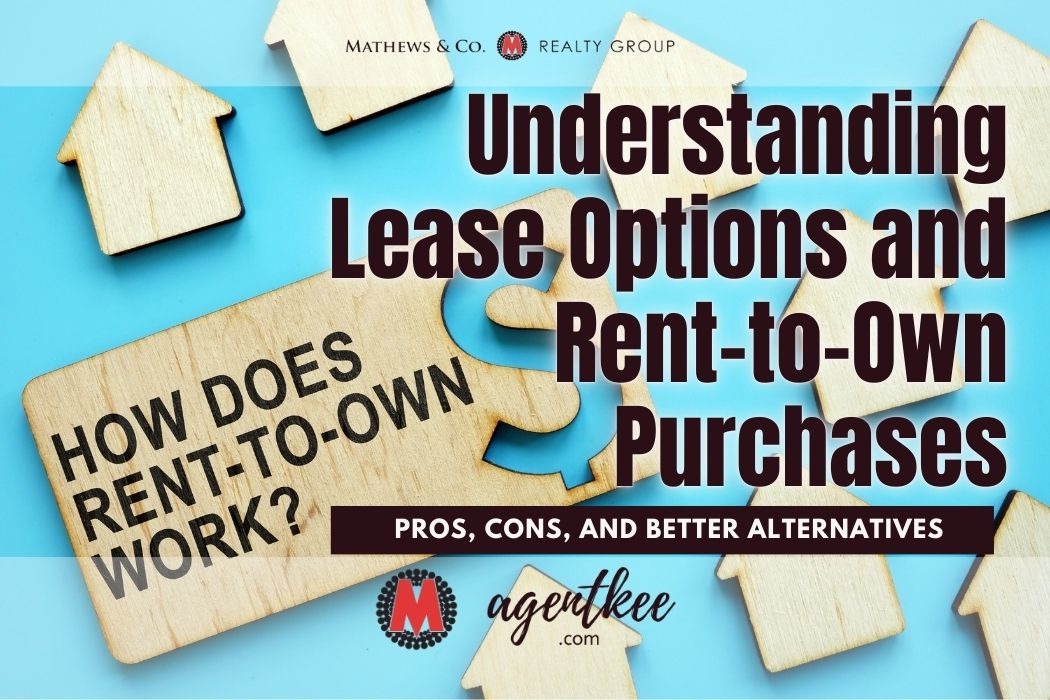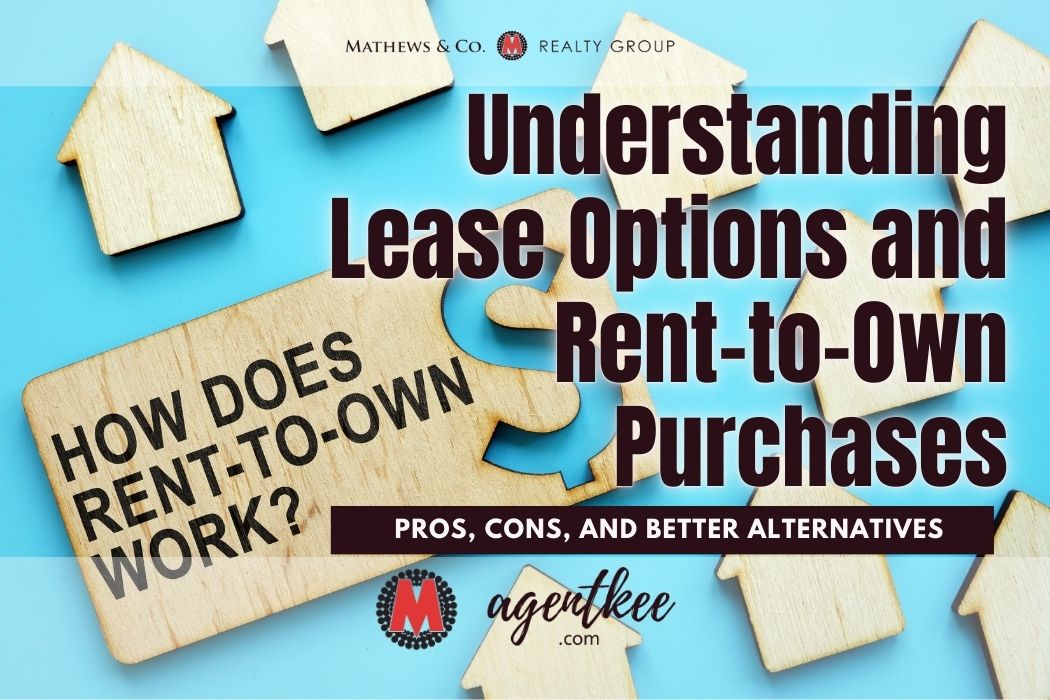Understanding Lease Options and Rent-to-Own Purchases: Pros, Cons, and Better Alternatives
In today's challenging housing market, where limited inventory, high prices, and rising interest rates make homeownership seem out of reach for many, lease options and rent-to-own agreements might appear to be an attractive solution. However, it's important to understand what these agreements entail and their potential drawbacks before diving in. What Are Lease Options and Rent-to-Own Agreements? Lease Options (also known as lease-to-buy or lease-to-own) involve a tenant entering into a contract with a property owner that allows the tenant to rent the property for a specified period with the option to purchase it at the end of the lease term. This typically includes:- Option Fee: An upfront fee (usually 2% to 7% of the purchase price) which grants the tenant the option to buy the property later. This fee is generally non-refundable.- Monthly Rent Payments: These may be higher than market rent, with a portion potentially going towards the down payment.- Purchase Option: At the end of the lease, the tenant can choose to purchase the property at the agreed-upon price. If they choose not to buy, they lose the option fee and any additional payments made towards the purchase. The Target Profile for Lease Options Sellers offering lease options typically target:1. Individuals with Credit Challenges: Those with poor credit scores who struggle to qualify for traditional mortgages.2. Individuals with Insufficient Savings: Those who have difficulty saving for down payments and closing costs.3. Individuals Facing High Debt-to-Income Ratios: Those with high levels of debt relative to their income, making it tough to secure a mortgage. Drawbacks of Lease Options While lease options might seem like a viable path to homeownership, they come with significant drawbacks: 1. Higher Costs: - Lease options often include higher monthly rent and additional fees, making them more expensive overall. Tenants end up paying more over the lease term compared to traditional renting or buying outright. 2. Risk of Forfeiture: - If the tenant cannot secure financing by the end of the lease term, they forfeit the option fee and any rent credits. This can result in a significant financial loss without gaining homeownership. 3. Limited Property Choice: - Tenants are typically restricted to the property offered in the lease option agreement, limiting their ability to choose a home that fits their needs and preferences. 4. Maintenance Responsibilities: - Depending on the contract, tenants might be responsible for maintenance and repairs during the lease period, adding to their financial burden. 5. Predatory Lending Concerns: - These agreements often favor sellers and investors, with terms that can be disadvantageous to buyers. This setup can resemble predatory lending practices, where the financial risks are disproportionately placed on the buyer. Alternatives to Lease Options Given the significant risks and disadvantages associated with lease options, here are some alternative strategies to help potential buyers achieve homeownership: For Individuals with Credit Challenges 1. Credit Repair Programs: - Seek help from non-profit credit counseling agencies like the [National Foundation for Credit Counseling (NFCC)](https://www.nfcc.org/) to create a plan for improving credit scores. - Use credit monitoring services like Experian Boost or Credit Karma to track and improve credit scores. 2. Secured Credit Cards: - Open a secured credit card account to build or rebuild credit with responsible usage. 3. Pay Down Existing Debt: - Focus on paying off high-interest debt first using strategies like the snowball or avalanche methods. 4. Timely Payments: - Ensure all bills are paid on time, as payment history significantly impacts credit scores. 5. Alternative Lending Options: - Explore FHA loans, which are more lenient with credit scores and offer lower down payment options. For Individuals with Insufficient Savings 1. Down Payment Assistance Programs: - Research local and state programs offering down payment assistance. For example, the [California Housing Finance Agency (CalHFA)](https://www.calhfa.ca.gov/) provides grants and second mortgage programs to help with down payments. 2. Savings Strategies: - Set up automatic transfers to a dedicated savings account to build a down payment fund. - Create a strict budget and reduce discretionary spending to increase savings. 3. Employer-Sponsored Programs: - Check if employers offer homebuyer assistance programs, which may provide grants or loans to help employees purchase homes. 4. First-Time Homebuyer Programs: - Utilize programs like those offered by [HUD](https://www.hud.gov/topics/buying_a_home), which provide educational resources and financial assistance for first-time homebuyers. For Individuals Facing High Debt-to-Income Ratios 1. Debt Reduction Plans: - Implement debt reduction strategies to lower overall debt, such as the debt avalanche or snowball methods. 2. Increase Income: - Consider additional i

 In today's challenging housing market, where limited inventory, high prices, and rising interest rates make homeownership seem out of reach for many, lease options and rent-to-own agreements might appear to be an attractive solution. However, it's important to understand what these agreements entail and their potential drawbacks before diving in.
What Are Lease Options and Rent-to-Own Agreements?
Lease Options (also known as lease-to-buy or lease-to-own) involve a tenant entering into a contract with a property owner that allows the tenant to rent the property for a specified period with the option to purchase it at the end of the lease term. This typically includes:
In today's challenging housing market, where limited inventory, high prices, and rising interest rates make homeownership seem out of reach for many, lease options and rent-to-own agreements might appear to be an attractive solution. However, it's important to understand what these agreements entail and their potential drawbacks before diving in.
What Are Lease Options and Rent-to-Own Agreements?
Lease Options (also known as lease-to-buy or lease-to-own) involve a tenant entering into a contract with a property owner that allows the tenant to rent the property for a specified period with the option to purchase it at the end of the lease term. This typically includes:- Option Fee: An upfront fee (usually 2% to 7% of the purchase price) which grants the tenant the option to buy the property later. This fee is generally non-refundable.
- Monthly Rent Payments: These may be higher than market rent, with a portion potentially going towards the down payment.
- Purchase Option: At the end of the lease, the tenant can choose to purchase the property at the agreed-upon price. If they choose not to buy, they lose the option fee and any additional payments made towards the purchase. The Target Profile for Lease Options Sellers offering lease options typically target:
1. Individuals with Credit Challenges: Those with poor credit scores who struggle to qualify for traditional mortgages.
2. Individuals with Insufficient Savings: Those who have difficulty saving for down payments and closing costs.
3. Individuals Facing High Debt-to-Income Ratios: Those with high levels of debt relative to their income, making it tough to secure a mortgage. Drawbacks of Lease Options While lease options might seem like a viable path to homeownership, they come with significant drawbacks: 1. Higher Costs:
- Lease options often include higher monthly rent and additional fees, making them more expensive overall. Tenants end up paying more over the lease term compared to traditional renting or buying outright. 2. Risk of Forfeiture:
- If the tenant cannot secure financing by the end of the lease term, they forfeit the option fee and any rent credits. This can result in a significant financial loss without gaining homeownership. 3. Limited Property Choice:
- Tenants are typically restricted to the property offered in the lease option agreement, limiting their ability to choose a home that fits their needs and preferences. 4. Maintenance Responsibilities:
- Depending on the contract, tenants might be responsible for maintenance and repairs during the lease period, adding to their financial burden. 5. Predatory Lending Concerns:
- These agreements often favor sellers and investors, with terms that can be disadvantageous to buyers. This setup can resemble predatory lending practices, where the financial risks are disproportionately placed on the buyer. Alternatives to Lease Options Given the significant risks and disadvantages associated with lease options, here are some alternative strategies to help potential buyers achieve homeownership: For Individuals with Credit Challenges 1. Credit Repair Programs:
- Seek help from non-profit credit counseling agencies like the [National Foundation for Credit Counseling (NFCC)](https://www.nfcc.org/) to create a plan for improving credit scores.
- Use credit monitoring services like Experian Boost or Credit Karma to track and improve credit scores. 2. Secured Credit Cards:
- Open a secured credit card account to build or rebuild credit with responsible usage. 3. Pay Down Existing Debt:
- Focus on paying off high-interest debt first using strategies like the snowball or avalanche methods. 4. Timely Payments:
- Ensure all bills are paid on time, as payment history significantly impacts credit scores. 5. Alternative Lending Options:
- Explore FHA loans, which are more lenient with credit scores and offer lower down payment options. For Individuals with Insufficient Savings 1. Down Payment Assistance Programs:
- Research local and state programs offering down payment assistance. For example, the [California Housing Finance Agency (CalHFA)](https://www.calhfa.ca.gov/) provides grants and second mortgage programs to help with down payments. 2. Savings Strategies:
- Set up automatic transfers to a dedicated savings account to build a down payment fund.
- Create a strict budget and reduce discretionary spending to increase savings. 3. Employer-Sponsored Programs:
- Check if employers offer homebuyer assistance programs, which may provide grants or loans to help employees purchase homes. 4. First-Time Homebuyer Programs:
- Utilize programs like those offered by [HUD](https://www.hud.gov/topics/buying_a_home), which provide educational resources and financial assistance for first-time homebuyers. For Individuals Facing High Debt-to-Income Ratios 1. Debt Reduction Plans:
- Implement debt reduction strategies to lower overall debt, such as the debt avalanche or snowball methods. 2. Increase Income:
- Consider additional income streams like part-time work, freelance opportunities, or gig economy jobs to boost overall income and improve the debt-to-income ratio. 3. Debt Consolidation:
- Look into debt consolidation loans to combine multiple debts into a single loan with a lower interest rate, reducing monthly payments. 4. Financial Planning Services:
- Consult with a financial advisor to create a personalized plan for managing debt and saving for a home. 5. Budgeting Tools:
- Use budgeting apps like Mint or YNAB (You Need A Budget) to track spending, manage finances, and identify areas to cut costs. By addressing these specific challenges with tailored strategies, individuals can improve their financial standing and move towards traditional homeownership opportunities, avoiding the pitfalls of rent-to-own and lease options. For more insights and detailed advice, tune in to "Selling Sacramento" this Wednesday at 1 PM. We'll explore other strategies to achieve homeownership without the drawbacks of rent-to-own agreements. Until next time, buh bye! Sources:
- National Foundation for Credit Counseling (https://www.nfcc.org/)
- California Housing Finance Agency (https://www.calhfa.ca.gov/)
- Experian Boost (https://www.experian.com/consumer-products/experian-boost.html)
- HUD First-Time Homebuyer Programs (https://www.hud.gov/topics/buying_a_home)

 vigna
vigna 





